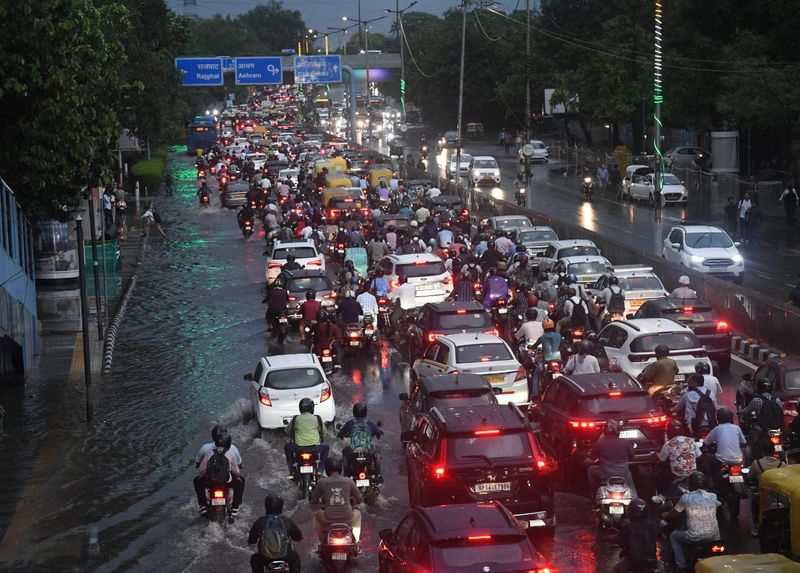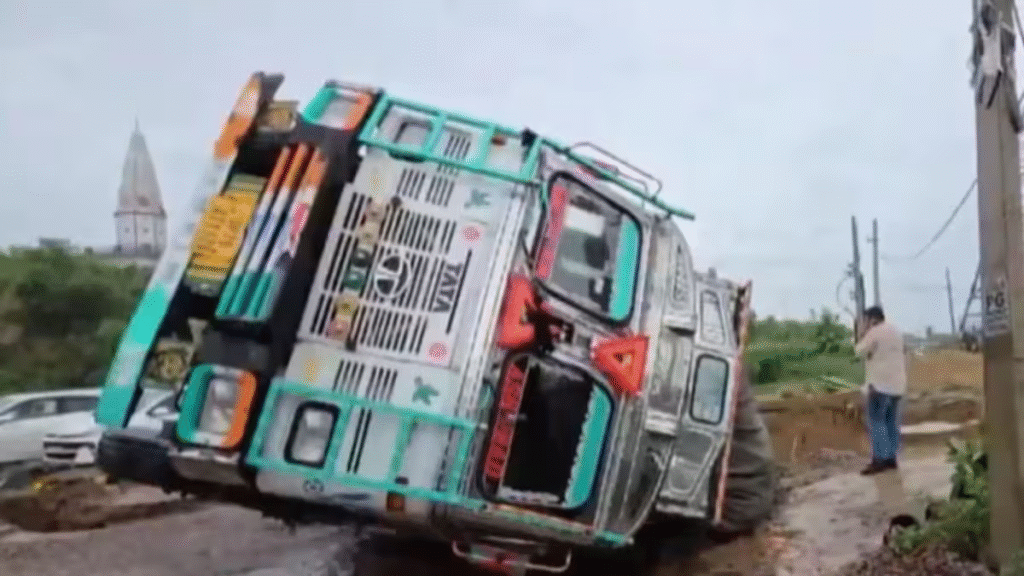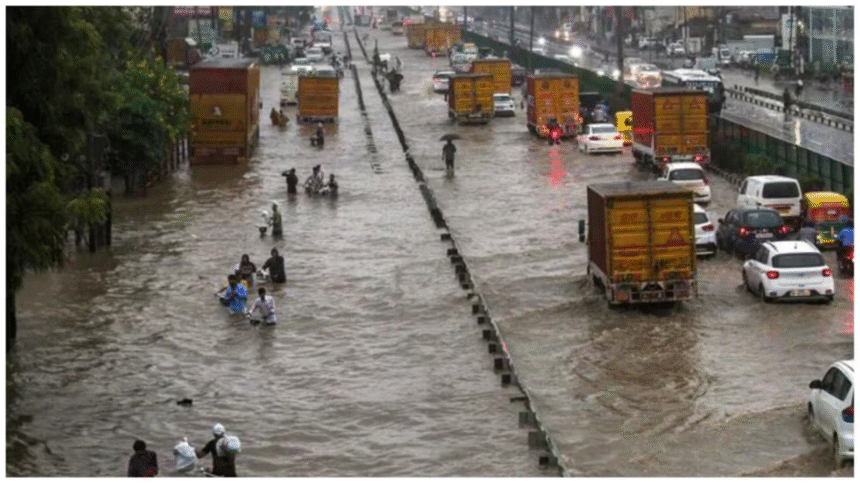Gurugram Rain Chaos: 400+ Distress Calls, Cratered Roads, Dozens of Cars Stranded Amid Flood Panic
Torrential rains wreak havoc in Gurugram, leaving roads cratered, cars stranded, and over 400 distress calls made. Panic grips commuters as floodwaters rise
A nightmarish day unfolded in Gurugram on Wednesday as torrential rain brought traffic to a standstill, leaving hundreds of vehicles stranded and triggering over 400 distress calls to the city’s traffic helpline within a span of just seven hours.

Frantic callers dialled 1097 and 9999981800 seeking help with waterlogged roads, stalled cars, broken-down buses and information on alternative routes to avoid snarls. According to TOI, most calls were about abandoned or stuck vehicles, with panicked commuters seeking urgent assistance.
Traffic police were deployed in full force to tackle the deluge and chaos. Over 222 vehicles were towed from flooded or gridlocked stretches of the city, using 32 cranes sourced from civic authorities. In many cases, drivers abandoned their vehicles mid-road as rising water made further movement impossible, officials said.
One of the distress calls that stood out involved a woman and her nine-year-old daughter stranded near Sheetla Mata temple. “She sounded frightened. She was unable to start her car because water got into it,” a traffic officer was quoted by TOI, adding that help was immediately dispatched, the car towed and the duo safely escorted home.
Critical areas bore the brunt of the disruption. Subash Chowk, Hero Honda Chowk, Rajiv Chowk, Sheetla Mata Chowk and Iffco Chowk were among the worst-hit junctions. Waterlogging crippled major intersections, with traffic crawling through deep water and broken roads.
A major cave-in on the Southern Peripheral Road exacerbated the situation, causing widespread jams extending to neighbouring sectors and Golf Course Road. Traffic police attributed the collapse to negligence by the Gurugram Metropolitan Development Authority (GMDA), which had failed to properly pave an area after installing a drainage pipe. Despite prior warnings from police, officials allegedly did not act in time, as per TOI. Eventually, a truck plunged into the resulting crater, forcing authorities to barricade the stretch and redirect traffic.

Adding to the woes were uprooted trees, which further choked traffic. Six major trees were cleared by the police from routes including Z Chowk to Iffco Chowk metro station, the road between Z Chowk and Gold Souk, outside Medanta hospital, Kankrola-Bhangrola Road and PWD resthouse road.
Faced with the growing crisis, Gurugram Police deployed 72 personnel across 23 vulnerable waterlogging hotspots. According to DCP Traffic Rajesh Mohan, the department also ensured traffic cops were present at over 100 points, extending their duty well beyond the usual 8 am-8 pm schedule, TOI reported. Officials have already banned the sale of meat on footpaths, near Kanwar camps, or in open areas along the pilgrimage route.
Gurugram, July 11, 2025 — A relentless downpour turned parts of Gurugram into a nightmare for thousands of commuters on Thursday as torrential rains battered the city, flooding roads, damaging infrastructure, and triggering panic. With over 400 distress calls made to emergency services in just a few hours, authorities struggled to respond to the rapidly escalating situation.
Major roads in the cyber hub—particularly in areas like Sohna Road, Golf Course Road, DLF Phase 3, and NH-48—were severely waterlogged. Large sections of the roads caved in, creating dangerous craters that brought traffic to a complete standstill. Commuters were left stranded in waist-deep water, many abandoning their vehicles to seek safety.
By early afternoon, visuals and videos from across the city began flooding social media, showing submerged cars, collapsed road sections, and desperate residents wading through murky waters. In several cases, roads developed massive potholes and sinkholes, raising serious concerns about Gurugram’s urban infrastructure and drainage preparedness.
Authorities confirmed that over 400 distress calls were made to emergency helplines, with residents reporting everything from stranded school buses to flooded basements and electrocution risks. Traffic police and emergency response teams were dispatched across key junctions, but waterlogged roads and poor visibility slowed operations significantly.
Many office-goers, particularly in the city’s bustling tech corridors and business parks, were caught completely off-guard. Several MNCs and IT companies reported attendance disruptions as employees were unable to reach offices. Ride-sharing platforms experienced a surge in demand, with fares spiking as availability dropped.
“I left Cyber City at 4 PM and reached Sector 57 by 9 PM,” said Prerna Malhotra, a private sector employee. “Every major route was flooded. People were standing on their car roofs trying to call for help.”
Schools and colleges also faced challenges, with some school buses stuck in knee-deep water for hours. Many parents took to social media, pleading with authorities to ensure the safety of students.
The Gurugram Metropolitan Development Authority (GMDA) and the Municipal Corporation of Gurugram (MCG) came under heavy criticism for what many termed a complete collapse of city planning. In response, GMDA officials stated that the rainfall recorded was over 110 mm in 3 hours, far exceeding forecast expectations.
“We deployed 70+ pumps and 25 teams across the city,” a GMDA spokesperson said. “But the intensity of rain exposed drainage blockages and ongoing construction-related weaknesses.”
Local politicians and residents alike have called for an immediate audit of ongoing road projects and a thorough overhaul of drainage infrastructure.
Experts say Gurugram’s recurring monsoon woes are no longer just seasonal nuisances—they are signs of deeper structural and climate-related challenges. Urban flooding in rapidly expanding cities like Gurugram, they warn, will become more frequent and dangerous without significant investment in resilient infrastructure.
As the skies clear temporarily, the question remains: how prepared is India’s millennial city to handle the next cloudburst?
Read Also : Language Dispute Turns Violent in India’s Richest State: 5 Injured, 20 Detained in Maharashtra Clash








